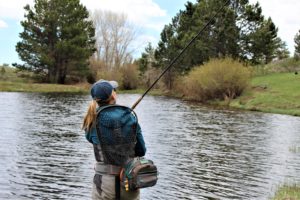
It happens. To all of us. Somedays more than others. And it’s frustrating. Your fly gets stuck in a tree or brush behind you, or across the river on the other side. With a regular fly rod and reel, you generally yank it pretty hard or snap your line and can get your fly free. But on a tenkara rod, yanking or snapping the line can cause further frustration when instead of just having a stuck fly, you now also have a broken rod. There is a safer way to do it and here it is:
- Take your rod and slowly and gently begin to pull perpendicular to the fly. If the fly is simply laying over a branch it may come off without hooking into something….so pull slowly. If it comes loose, Yeah! If it doesn’t then:
- With slight tension on the rod to fully extend your line, beginning at the bottom-most section (the widest section closest to the handle), begin collapsing your rod, section by section, causing tension to be placed on the line and hopefully stretching the branch and gently bringing it closer to you. If you can reach the branch and then ultimately the fly. Grab the branch and work from there to release the fly. Remember to be cognizant of any rod sections still extended and particularly the tip section. If you can’t reach and grab the branch your fly is caught on then…
- Continue collapsing the rod carefully until eventually, the line is within reach.
- As soon as you can, take hold of the line, releasing any pressure or tension from the rod sections and particularly, the tip sections.
- Once you have a firm grip on the line and all sections are securely collapsed inside the rod, give the fly line a good old tug or yank! Either the fly will come loose or the tippet will break. (Preferable the fly will come loose. Always try to avoid leaving leaders, tippet or flies in trees and surrounding foliage as they are a hazard to wildlife including birds and well, it’s littering and no one is following you, picking up your trash. Be a good steward of the river.)
- Once the fly releases, give it a good check over, including your tippet for any bend, fractures or nicks.
- Note that you may need to take a few extra steps out towards your fly to accomplish this. Be careful in swift water.
This same method works for when your fly is caught above your head in a tree. There will always be exceptions but 99.9% of the time you can free your fly using this method and spare your rod from unnecessary breaks.




Try doing what I have discovered as a way of getting your ‘Fly’, unhooked, providing it is ‘D’barbed, and that it is in reach, use your ‘Rod Tip’, as the ‘disgorger’…..? Like all these, there is an art to it…!!
Thanks for reading and commenting. Using your rod tip to dislodge your stuck fly from a tree or bush can sometimes work but you run the VERY HIGH RISK of breaking your tip section. Your rod tip is the most delicate section of your rod and if you use it to dislodge your fly (since your line is still attached to it) you also run the risk of getting even more tangled. PLEASE BEWARE of doing this. It may work, and if you are desperate, then proceed with caution. But it is risky for sure and generally not something we would recommend. Yes, an art form for sure.
Great tips. It happens to everyone on the water.
Thanks for reading. And it sure does happen to everyone! We all have those days when it feels like our flies spend more time in trees and bushes than in the water. On days like that you have to breathe deeply and just enjoy the beautiful surroundings. Lol!